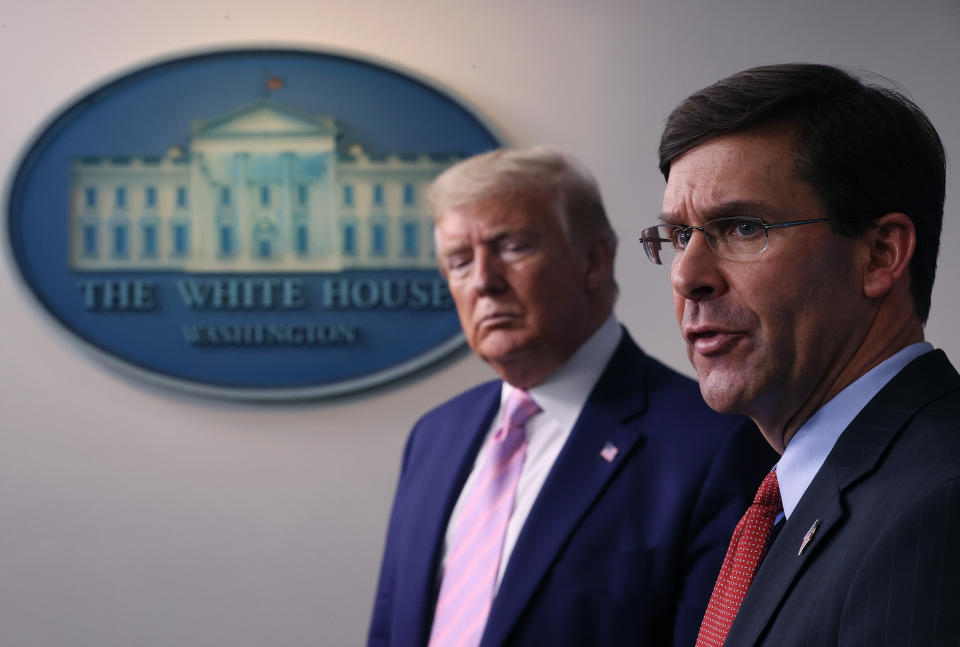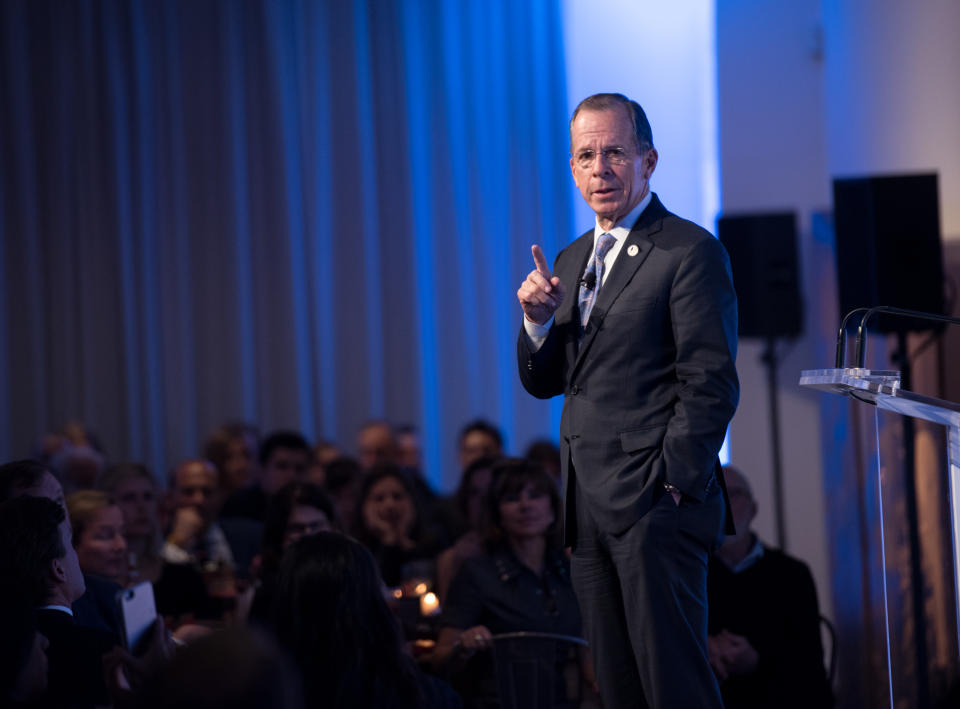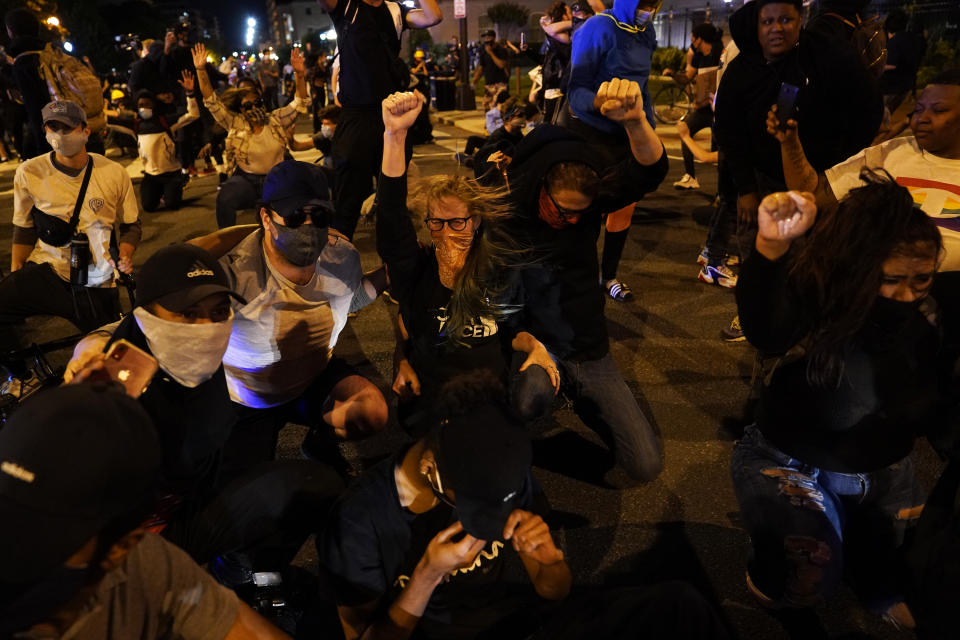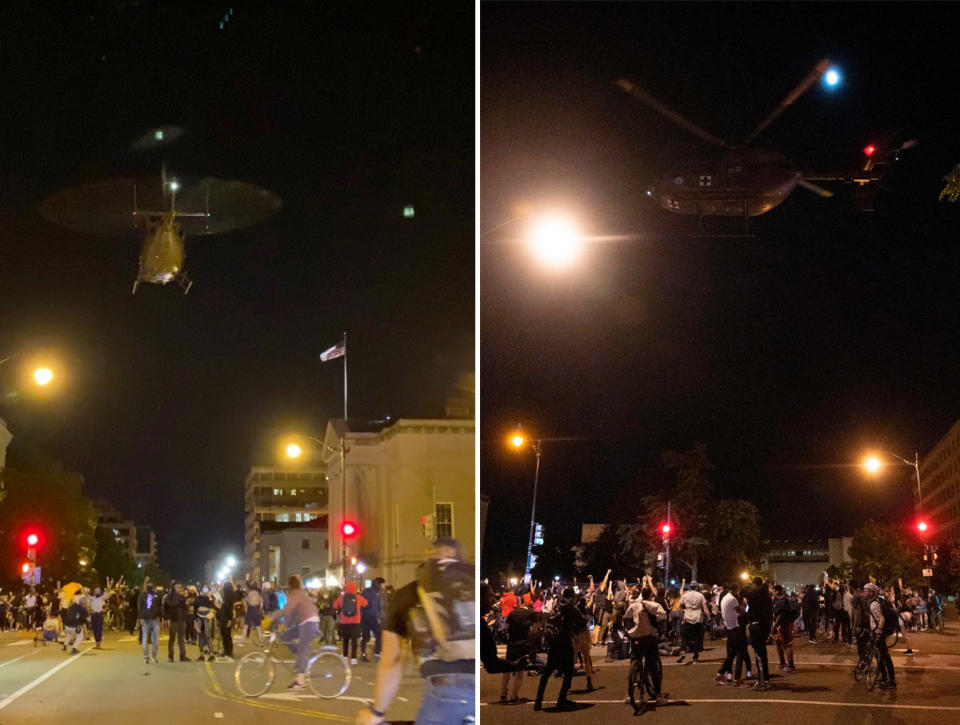After breaking with Trump, Esper is still secretary of defense 'as of right now'
White House press secretary Kayleigh McEnany did not go out of her way Wednesday to assure reporters that Donald Trump still had confidence in Defense Secretary Mark Esper, who earlier in the day broke with the president over whether to use U.S. troops to quell protests on the streets of American cities.
“As of right now, Secretary Esper is still Secretary Esper,” McEnany said in a less-than-glowing assessment of whether the defense secretary’s position in the administration was safe.
Speaking to reporters at the Pentagon on Wednesday, Esper declared he did not support Trump’s suggestion of using active-duty U.S. soldiers to put down sometimes violent protests over the killing of African-American man George Floyd by a Minneapolis police officer.
“The option to use active-duty forces in a law enforcement role should only be used as a matter of last resort, and only in the most urgent and dire of situations,” Esper said. “We are not in one of those situations now. I do not support invoking the Insurrection Act.”
However, after an Associated Press report from early afternoon on Wednesday that said the Defense Department was sending home the roughly 1,600 active-duty troops who had been deployed close to the District of Columbia for possible use controlling the protests in that city, Pentagon spokesman Chuck Prichard said that would not be happening after all. “There’s no change,” Prichard said. “The active-duty troops will remain in the National Capital Region, but they are outside of the district proper. There are no plans to send them back to their home posts.”
Esper also used his press conference to decry the killing of Floyd, a black man who died May 25 after a white police officer knelt on his neck for nearly nine minutes as Floyd begged for his life. Esper called it “a horrible crime” and urged that “the officers on the scene that day should be held accountable for his murder.”

The defense secretary said that on behalf of himself and his department he wanted to extend “the deepest of condolences” to Floyd’s family and friends. “Racism is real in America, and we must all do our very best to recognize it, to confront it and to eradicate it,” he said.
Prior to Wednesday morning’s press conference, Esper had drawn fire from retired senior military leaders and others for a series of perceived missteps, including his weeklong silence on the Floyd case and his telling the nation’s governors that they needed to “dominate the battle space” in responding to the protests. But it was his participation as part of Trump’s entourage in a Monday evening walk from the White House through Lafayette Park to the historic St. John’s Church, where Trump made brief remarks while brandishing a Bible in what appeared to be little more than a photo opportunity for the president, that drew the fiercest criticism.
The short trip from the White House to the church, which had been slightly damaged by a fire the previous day, was preceded by one of the most high-profile incidents of police violence during the protests, when law enforcement officials, including some National Guard troops, forced a largely peaceful crowd of protesters back in an apparent effort to clear a path for Trump and his entourage. The televised beating the police gave to an Australian television crew during the incident prompted the government in Canberra to open an investigation.
James Miller, a former undersecretary of defense for policy under President Barack Obama, cited the episode in a letter to Esper announcing his immediate resignation from the Defense Science Board. “You may not have been able to stop President Trump from directing this appalling use of force, but you could have chosen to oppose it,” wrote Miller in his letter, which was published by the Washington Post. “Instead, you visibly supported it.”
After a background briefing for reporters by Defense Department officials Tuesday morning failed to quell the controversy, Esper addressed it Wednesday. While he was aware that the excursion from the White House would involve a trip to the church, Esper said, he “was not aware that a photo op was happening.”
“I do everything that I can to try to stay apolitical and try and stay out of situations that may appear political, and sometimes I’m successful at doing that and sometimes I’m not as successful,” he added.

Esper said he was also unaware prior to the event of the Park Police’s plans to clear the park. “They had taken what actions I assume they felt was necessary given what they faced, but I was not briefed on the plans and was not aware of what they were doing,” he said.
Even before the walk across Lafayette Park, Esper had made headlines on Monday for making that statement about “dominat[ing] the battle space” in a phone call between senior administration officials, including the president, and the nation’s governors.
His remark drew a furious rejoinder from retired Army Gen. Tony Thomas, the former head of U.S. Special Operations Command. “The ‘battle space’ of America???” Thomas wrote in a tweet Monday afternoon. “Not what America needs to hear…ever, unless we are invaded by an adversary or experience a constitutional failure…ie a Civil War…”
Retired Navy Adm. Michael Mullen, the former chairman of the Joint Chiefs of Staff, was similarly critical in an impassioned article he wrote for the Atlantic. “Even in the midst of the carnage we are witnessing, we must endeavor to see American cities and towns as our homes and our neighborhoods,” he wrote. “They are not ‘battle spaces’ to be dominated, and must never become so.”

Esper, a former Army officer, tried to walk back his comment during Wednesday’s press conference. “It is part of our military lexicon that I grew up with,” he said. “It’s what we would routinely use to describe a bounded area of operations. It’s not a phrase focused on people.” However, he added that “in retrospect I would use different wording.”
Wednesday’s press conference represented the first time that Esper had directly addressed the Floyd killing and the issue of racial injustice. On Tuesday evening he issued a one-page statement in which he told the military how proud he was of its professionalism, but only obliquely referred to the Floyd protests by saying he was “committed to upholding the rule of law and protecting life and liberty, so that the violent actions of a few do not undermine the rights and freedoms of law-abiding citizens.”
Asked why he had taken a week to speak out about Floyd’s death and the racial injustices that underpinned both that incident and the protests that followed, Esper cited his desire to keep the Defense Department out of politics. “What happened to George Floyd happens way too often in this country, and most times we don’t speak about these matters as a department,” he said. “But as events have unfolded over the past few days, it became very clear that this was becoming a very combustible national issue and … I had made the determination as events escalated over the last 72 hours that the moment had reached a point where it warranted a clear message to the department about our approach.”
The Washington Post reported Tuesday that the Trump administration had told members of the Joint Chiefs of Staff not to speak out on the Floyd protests until Esper had done so, but on Wednesday Esper said it was the chiefs who wanted him to go first. “Most of the chiefs wanted to take the lead from me,” he said. Esper said he told the chiefs that “I was going to send the initial message out to set the tone, to express my views, and then I’d give them the space to share their views as well.”

Prior to Esper’s press conference, the only service chief to have addressed the Floyd killing and related issues was Air Force Chief of Staff Gen. David Goldfein, who is due to retire soon. The Air Force released a video Tuesday of Goldfein speaking about it with his senior enlisted adviser, Chief Master Sergeant of the Air Force Kaleth Wright, an African-American who had himself posted a lengthy statement on social media Monday expressing his outrage at the Floyd killing.
However, shortly after Esper had concluded his remarks, the Army leadership, including Secretary of the Army Ryan McCarthy, Army Chief of Staff Gen. James McConville and Sergeant Major of the Army Michael Grinston, issued a statement pledging the Army’s support of the American people’s constitutional right “peaceably to assemble and to petition the government for a redress of grievances,” while acknowledging that as white men “we can never fully understand the frustration and life experiences of people of color.”
Chief of Naval Operations Adm. Michael Gilday also issued a video address to the Navy Wednesday in which he decried Floyd’s killing. “It’s not the first time,” Gilday said. “It’s happened time and time again in our country.”
Conspicuous by his absence from Wednesday’s press conference was Army Gen. Mark Milley, the chairman of the Joint Chiefs of Staff, who has also been criticized for joining Trump’s entourage during Monday’s church photo op. Other than impromptu remarks to journalists as he inspected National Guard forces near the White House that night, Milley has not commented publicly on Floyd’s death or the military’s role during the protests. Milley’s office declined to answer a list of questions about the chairman’s participation in that event.
Another senior military figure to comment on the unrest prior to Esper was Air Force Gen. Joseph Lengyel, chief of the National Guard Bureau. During a call with reporters on Tuesday, Lengyel described the Guard’s mission of supporting civilian authorities during civil unrest as being not only “one of the most difficult and dangerous missions” that Guard forces have to perform within the United States, but “probably the mission that we like doing the least.”
For Guard forces, Lengyel said, “this mission is an uncomfortable mission, they don’t like doing it.”

In fact, Guard troops have found themselves in the spotlight as a result of their actions in the nation’s capital. One of the most controversial elements during the protests in Washington occurred when at least one National Guard UH-72 Lakota medical evacuation helicopter hovered over a group of protesters in an apparent attempt to disperse them using the downwash from its rotor blades, a tactic U.S. military forces have been known to use in combat operations abroad. On Tuesday, the commander of the D.C. National Guard, Maj. Gen. William Walker, ordered an investigation into the incident. Esper said he had directed Army Secretary McCarthy, who is in the D.C. National Guard’s chain of command, to order the investigation.
After about 20 minutes, following an opening statement and responding to a handful of questions, Esper ended his press conference abruptly, saying he was wanted at the White House.
_____
Read more:



